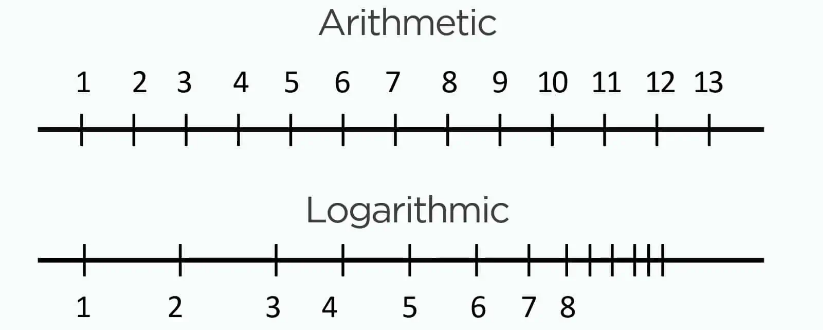AVEM Classroom 07 - Human Perception ( Harmonics and Logarithms)
Not only is our perception of sound intensity logarithmic, but so are our senses. The Psychophysical law (or Weber-Fechner law) describes this generalization in psychology. It states that the intensity of a sensation is proportional to the logarithm of the intensity of the stimulus causing it. So, the relationship between our sensations—such as sight, hearing, and touch—and the stimulus is logarithmic.
Harmonics
Complex audio waveforms often include tones with frequencies that are multiples of each other. If a string is plucked to produce the musical note A, which has a frequency of 220Hz, the string will also produce vibrations at 440Hz (220 x 2), 660Hz (220 x 3), 880Hz (220 s 4),1100Hz (220 x 5), 1320Hz (220 x 6), 1540Hz (220 x 7), 1760Hz (220 x 8), erc. These additional vibrations at multiples of the 220Hz note are known as the harmonics of the fundamental 220Hz frequency. The relative proportions of these harmonics frequencies are what help to give a particular note its characterisitc sound or timbre, allowing us to recognize the differences between the same note played on a guitar, a mandolin, a ukelele, a balalaika, a double-bass, or a banjo.
The fundamental frequency is also known as the first harmonic frequency. In the previous example, 220Hz is the first harmonic, the second harmonic is 440Hz, the third harmonic is 660Hz, the fourth harmonic is 880Hz, the fifth harmonic is 1100Hz, the sixth harmonic is 1320Hz, and so on.
Logarithms
The logarithm (log10 or, more commonly, just log) of a number is how many times the number 10 must be multiplied by itself to get that number. For example, the log of 1000 is 3, because 1000 is 10 multiplied by itself three times (10 x 10 x 10), usually shown as 103. Similarly, the log of 100,000,000 is 8 (108), and the log of 0.0001 is -4 (10-4). As you can see in Table 4-2, using the logarithms of numbers enables us to express larges of values in a more compact format without the need for all the leading and trail-ing zeros.
On a standard ruler, each scale mark represents a single unit, whereever it's located on the ruler. The distance between 3 and 6 on the scale represents a difference of three units. There is a one-to-one relationship between the units shown and the units represented. This is a linear scale.
However, if we make a ruler with a logarithmic scale, each scale mark on the ruler represents a logarithmic value of 1, which is a 10 times factor, to the next scale mark. If we move to the right, each scale unit represents a number 10 times larger than its predecessor. If we move to the left, each scale represents a number 1/10 of its predecessor. Look at the graph in in Figure 4-4. The top row represents a linear scale, and the bottom row represents a logarithmic scale.

Figure 4-4 Comparing a linear scale and logarithmic scale

Why is this important? Because humans perceive differences between sound pressure logarithmically, not linearly, over a range of about 3,000,000:1 between the threshold of hearing and the onset of acoustic pain. Therefore, a base-10 logarithmic scale is used to measure, record, and discuss sound level differences.
Decibels
The AV industry frequently uses decibel measurements, so it is important for you to understand what decibels are and how they are used.
The decibel (dB) is a measure of the logarithmic ratio between two quantities of the same physical property such as pressure, power, or voltage. As a logarithmic scale, it is well suited to describing ratios with a potentially very large range of values.
The basic unit, the Bel, was named after telecomunicationspioneer Alexander Graham Bell, but the Bel has turned out to be too large for most practical purpose, so the decibel (dB) is the standard unit used (1dB = 0.1 Bel).
Bel = log10 (quantity1/quantity2)
dB = 10 x log10 (quantity1/quantity2)
- active loudspeaker
- active speaker
- active subwoofer
- alto
- analog crossover
- analog equalizer
- analog mixer
- audiocenter
- b205d
- behringer
- bmb
- bosch
- box speaker
- church
- column speaker system
- convention center
- csp-610
- csp612
- css1720
- csw-115
- da2250
- da2500
- dad-500
- dad950
- dar-350h
- dcx2496le
- digital loudspeaker management
- digital mixer
- digital snak2
- digital snake
- dl16
- dlm408plus
- dm220
- dm24.8
- dm-24.8
- dm48.20
- dpe-2.10
- dpm4.13mk2
- dsp5211
- dsppa
- dsspa
- dvs-4t
- ea5118
- education
- emix
- emma-120b
- emma-835zsmkll
- empa-8250mkii
- empa-8500
- empa-8500 mkii
- empa-8500mkll
- emws884
- emws884b
- emws-884w
- ep1500
- ep2000
- ep512
- fbq-1502
- fbq-1502hd
- fbq3102hd
- hm1461fx
- hm822fx
- ic electronics
- iq15
- iq18b
- iva
- iva audio pack
- karaoke
- kfc
- kla210
- kla210dsp
- kla210wp
- kla218
- kla218dsp
- kla28
- kla815b
- klark teknik
- km1700
- l65
- l65+l65a
- l65+l65s
- l65a
- lbb-3200/00
- lbc-3200/00
- lbc-3210/00
- line array
- live music venue
- live-8
- loudspeaker
- lt10a
- lt12p
- m18b
- m32
- m32 live
- m7.0mkii
- m-7.0mkii
- ma12
- ma15
- masjid
- microphone
- microphones
- midas
- mixer
- mixing amplifier
- mr-28u
- multipurpose hall
- mxi.1222cfx
- mxi.1422
- mxi.1422cfx
- mxi.1622cfx
- my boss club
- pa sistem untuk masjid
- pa system for auditorium
- pa system for bar
- pa system for cafe
- pa system for church
- pa system for court
- pa system for goverment
- pa system for hall
- pa system for hotel
- pa system for mosque
- pa system for multipurpose hall
- pa system for restaurant
- pa system for school
- pa system for temple
- pa system for worship
- passive loudspeaker
- passive subwoofer
- pc260
- pf-118b+wp
- pf-12+wp
- pf-15+wp
- pm827
- pm8270
- pm-8270
- power amplifier
- power mixer
- powered mixer
- pro-12.0
- pro256dx
- pro26dx
- pro7.0
- pro-9.0
- proel
- pro-ud2
- ps15r2
- qx602mp3
- rx10mk2
- rx-10mk2
- rx12mk2
- rx-12mk2
- rx15mk2
- rx-15mk2
- rx-5mk2
- s16
- s32
- sa3118
- sa312
- sa315
- shure
- smaart tuning
- stadium
- stage monitor
- sub118b
- sub-118b
- subwoofer
- t2208
- tannoy
- test test
- tfx122m-an
- th20/tu60ml
- topp pro
- tpm2.3
- tpm-2.3
- tpx-122m
- turbosound
- u2004ch4
- uum
- ux34d
- v4fx
- ve-20
- vp1220
- wd12av2
- wd15av2
- weather proof loudspeaker
- wing
- wireless microphone
- ws740
- x10
- x10a
- x12a
- x15
- x15a
- x1622usb
- x1832usb
- x32
- x32 compact
- x32 producer
- x8
- x8a
- xenyx x1204usb
- xenyx x2442usb
- xr18










